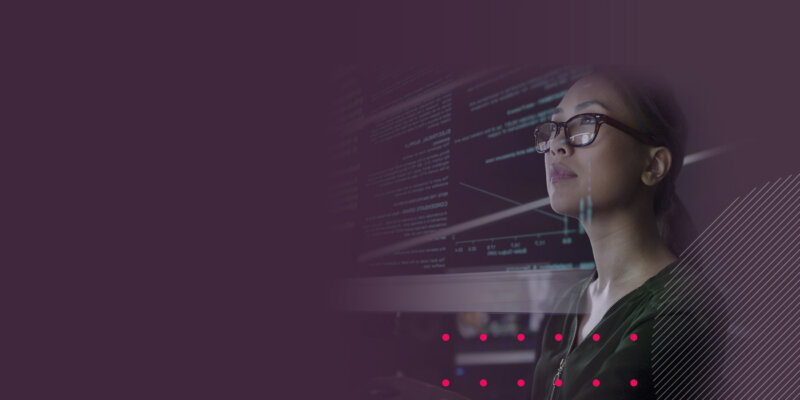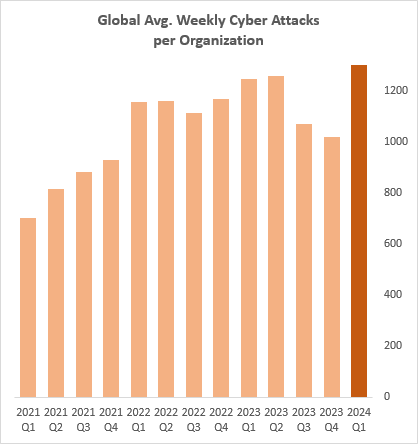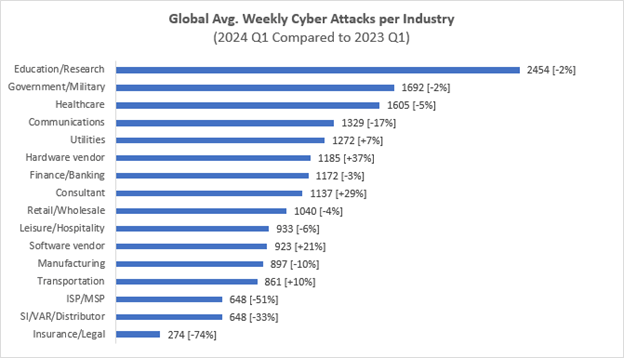
Shifting Attack Landscapes and Sectors in Q1 2024 with a 28% increase in cyber attacks globally
- Recurring increase in cyber attacks: Q1 2024 saw a marked 28% increase in the average number of cyber attacks per organization from the last quarter of 2023, though a 5% increase in Q1 YoY
- Sustained Industry Attacks focus: The Hardware Vendor industry saw a substantial rise of 37% cyber attacks YoY, as the Education/Research, Government/Military and Healthcare sector maintained their leads as the most heavily attacked sectors in Q1 2024
- Contrasting Regional Variances: The Africa region saw a notable 20% increase in cyber attacks, as opposed to Latin America, which reported a 20% decrease YoY
- Ransomware continues to surge: Europe saw a YoY 64% surge in ransomware attacks followed by Africa (18%), though North America emerged as the region most impacted by ransomware attacks with 59%out of close to 1000 published ransomware attacks from ransomware ‘shame sites’
The realm of cyber security is an ever-evolving battlefield. As we step into 2024, the shadows of 2023’s massive cyber threats still loomed, setting a precedent for what was to come. The first quarter of 2024 has seen an intriguing shift in the landscape of cyber attacks, both in frequency and in the nature of threats.
Global Cyber Security Trends for Q1 2024
In Q1 2024, Check Point Research (CPR) witnessed a notable increase in the average number of cyber attacks per organization per week, reaching 1308, marking a 5% increase from Q1 2023 and a 28% increase from the last quarter of 2023. This escalation is not just a number but a stark reminder of the persistent and evolving threat landscape, and the substantial increase from Q4 2023 accentuates a worrying trend of rapid escalation in cyber threats.

Global Attacks Per Industry
The Education/Research sector experienced a significant blow with an average of 2454 attacks per organization weekly, leading the chart in targeted industries, followed by the Government/Military (1692 attacks per week) and Healthcare (1605 attacks per organization) sectors, signalling an alarming vulnerability in sectors that are pivotal to societal function.
However, it is the substantial year-on-year increase in attacks on the Hardware Vendor industry, rising by 37%, which underlines a strategic shift in target preference by cybercriminals. This industry’s increasing reliance on hardware for IoT and smart devices makes these vendors lucrative targets for cybercriminals.

Regional Analysis of Overall Attacks
Regionally, Africa surged to the forefront with an average of 2373 attacks per week per organization, a 20% jump from the same period in 2023. In contrast, Latin America showed a 20% decline, perhaps indicating a shift in focus or improved defensive measures in the region; another reason could be a temporary shift in focus by cybercriminals on other more vulnerable regions across the world. The data also revealed a nuanced picture of varying intensities and types of cyber threats in different regions, underscoring the complex and dynamic nature of cyber warfare.
| Region | Avg weekly attacks per org | YoY Change |
| Africa | 2372 | +20% |
| APAC | 2133 | +16% |
| Latin America | 1267 | -20% |
| Europe | 1030 | +0.4% |
| North America | 972 | +2% |
Ransomware Attack Insights per Region and Industry
In Q1 2024, North America was the region most impacted by Ransomware attacks, accounting for 59% out of close to 1000 published ransomware attacks*, followed by Europe (24%) and APAC (12%). The largest increase in reported attacks compared to Q1 2023 was seen in Europe, with a significant 64% increase. This significant increase could be attributed to factors such as increased digitization of services and regulatory environments that may make organizations more vulnerable or visible targets. In contrast, the North America saw a 16% increase, indicating a sustained focus by attackers on this region.
The most impacted Industry globally was the Manufacturing sector, accounting for 29% of published ransomware attacks and having almost double the amount of reported attacked YoY, followed by the Healthcare industry with 11% of the attacks (and 63% increase YoY), and Retail/Wholesale with 8% of the attacks.
The Communications sector saw the highest increase YoY in ransomware attacks with 177%, though it constituted only 4% of the published attacks in the quarter. The Communications sector’s surge in cyberattacks YOY could have been fueled by rapid digital transformation, integrating technologies like 5G and IoT, which expand vulnerabilities, while its critical role and handling of sensitive data make it a prime target for diverse threats, including state-sponsored espionage and data theft. The Manufacturing sector had the second highest increase in ransomware attacks with 96% YoY, and is a common prime target due to its heavy reliance on interconnected technology and weakened security capabilities due to the usage of legacy industrial technologies.
(*) This section features information derived from ransomware “shame sites” operated by double-extortion ransomware groups which posted the names and information of victims. The data from these shame sites carries its own biases, but still provides valuable insights into the ransomware ecosystem.
| Region | Percent out of Published Ransomware Attacks | YoY Change in Amount of Published Attacks |
| North America | 59% | +16% |
| Europe | 24% | +64% |
| APAC | 12% | -13% |
| Latin America | 4% | +14% |
| Africa | 1% | +18% |
| Industry | Percent out of Published Ransomware Attacks | YoY Change in Amount of Published Attacks |
| Manufacturing | 29% | +96% |
| Healthcare | 11% | +63% |
| Retail/Wholesale | 8% | -4% |
| Finance/Banking | 6% | +22% |
| Insurance/Legal | 5% | +49% |
| Education/Research | 5% | -7% |
| Transportation | 5% | +28% |
| Communications | 4% | +177% |
| Government/Military | 3% | -40% |
| Software vendor | 3% | -61% |
Practical Organization Strategies
Businesses must adopt a multi-faceted approach to cyber security, encompassing robust data backups, frequent cyber awareness training, timely security patches, strong user authentication, and advanced anti-ransomware solutions. Proactive engagement with AI-powered defenses can significantly bolster an organization’s resilience against these threats.
In response to these escalating threats which are becoming more sophisticated, advancements in defense techniques especially in threat detection and analysis and spotting anomalies and new attack patterns early, particularly in AI, have become pivotal. For instance, Check Point’s ThreatCloud AI, which underpins all its solutions, leverages AI and big data to counter sophisticated threats while minimizing false positives. It processes vast amounts of data and indicators of compromise daily. A practical example of its effectiveness is in handling zero-day attacks: a malicious link identified in the US is instantly blocked and this intelligence is shared globally, allowing a similar attack in Australia to be thwarted within seconds, averting potential harm.
The Drive to Defend Continues
The first quarter of 2024 has underscored the need for adaptive cybersecurity strategies to combat the evolving threat landscape. The increased attacks on specific industries and regions, coupled with the complexity of ransomware tactics, highlight the necessity for comprehensive and prevention-first approaches to cybersecurity. As we continue to navigate this challenging terrain, awareness, preparedness, and innovation in defense strategies remain our strongest allies.









